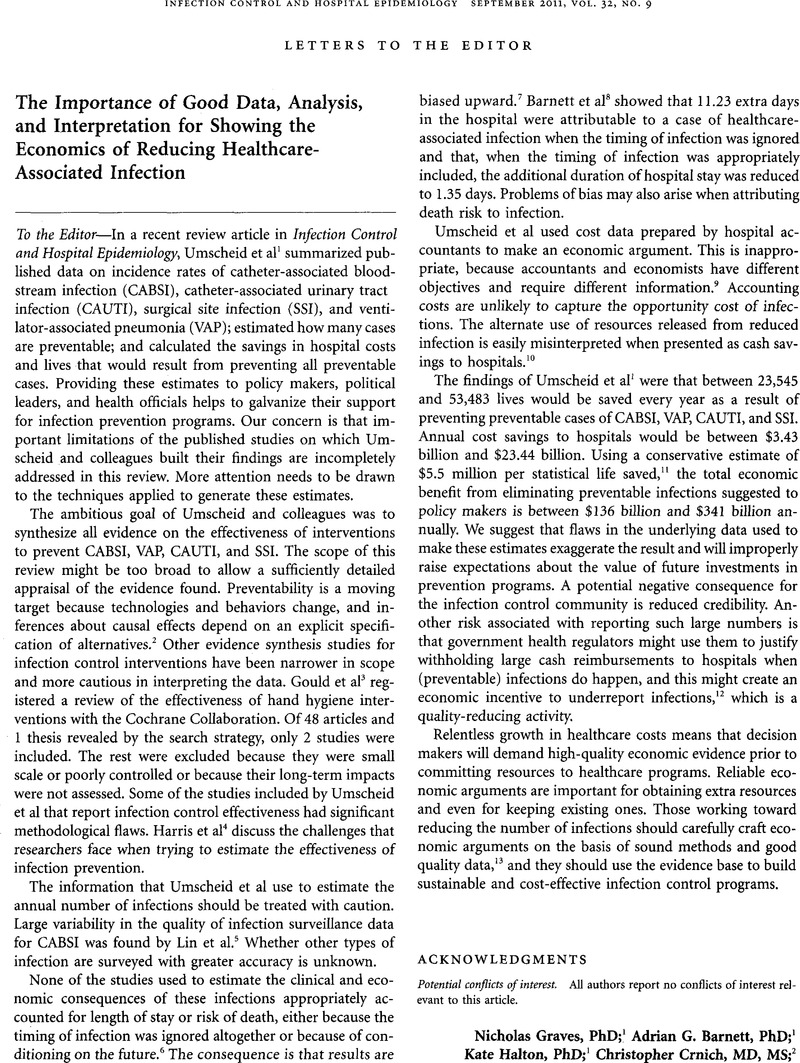Crossref Citations
This article has been cited by the following publications. This list is generated based on data provided by Crossref.
Umscheid, Craig A.
Mitchell, Matthew D.
and
Doshi, Jalpa A.
2011.
Reply.
Infection Control & Hospital Epidemiology,
Vol. 32,
Issue. 9,
p.
928.
Huskins, W. Charles
2012.
Quality improvement interventions to prevent healthcare-associated infections in neonates and children.
Current Opinion in Pediatrics,
Vol. 24,
Issue. 1,
p.
103.
Gurieva, Tanya
Bootsma, Martin C. J.
Bonten, Marc J. M.
and
Fraser, Christophe
2013.
Cost and Effects of Different Admission Screening Strategies to Control the Spread of Methicillin-resistant Staphylococcus aureus.
PLoS Computational Biology,
Vol. 9,
Issue. 2,
p.
e1002874.
Harbarth, S.
2013.
What can we learn from each other in infection control? Experience in Europe compared with the USA.
Journal of Hospital Infection,
Vol. 83,
Issue. 3,
p.
173.
Graves, Nicholas
2014.
How costs change with infection prevention efforts.
Current Opinion in Infectious Diseases,
Vol. 27,
Issue. 4,
p.
390.
Stevens, V.
Geiger, K.
Concannon, C.
Nelson, R.E.
Brown, J.
and
Dumyati, G.
2014.
Inpatient costs, mortality and 30-day re-admission in patients with central-line-associated bloodstream infections.
Clinical Microbiology and Infection,
Vol. 20,
Issue. 5,
p.
O318.
Leistner, R.
Hirsemann, E.
Bloch, A.
Gastmeier, P.
and
Geffers, C.
2014.
Costs and prolonged length of stay of central venous catheter-associated bloodstream infections (CVC BSI): a matched prospective cohort study.
Infection,
Vol. 42,
Issue. 1,
p.
31.
Allignol, Arthur
Beyersmann, Jan
Gerds, Thomas
and
Latouche, Aurélien
2014.
A competing risks approach for nonparametric estimation of transition probabilities in a non-Markov illness-death model.
Lifetime Data Analysis,
Vol. 20,
Issue. 4,
p.
495.
Greco, Giampaolo
Shi, Wei
Michler, Robert E.
Meltzer, David O.
Ailawadi, Gorav
Hohmann, Samuel F.
Thourani, Vinod H.
Argenziano, Michael
Alexander, John H.
Sankovic, Kathy
Gupta, Lopa
Blackstone, Eugene H.
Acker, Michael A.
Russo, Mark J.
Lee, Albert
Burks, Sandra G.
Gelijns, Annetine C.
Bagiella, Emilia
Moskowitz, Alan J.
and
Gardner, Timothy J.
2015.
Costs Associated With Health Care–Associated Infections in Cardiac Surgery.
Journal of the American College of Cardiology,
Vol. 65,
Issue. 1,
p.
15.
Stevens, Vanessa W.
Khader, Karim
Nelson, Richard E.
Jones, Makoto
Rubin, Michael A.
Brown, Kevin A.
Evans, Martin E.
Greene, Tom
Slade, Eric
and
Samore, Matthew H.
2015.
Excess Length of Stay Attributable to Clostridium difficile Infection (CDI) in the Acute Care Setting: A Multistate Model.
Infection Control & Hospital Epidemiology,
Vol. 36,
Issue. 9,
p.
1024.
Manoukian, S.
Stewart, S.
Dancer, S.
Graves, N.
Mason, H.
McFarland, A.
Robertson, C.
and
Reilly, J.
2018.
Estimating excess length of stay due to healthcare-associated infections: a systematic review and meta-analysis of statistical methodology.
Journal of Hospital Infection,
Vol. 100,
Issue. 2,
p.
222.
Graves, N.
Mitchell, B.G.
Otter, J.A.
and
Kiernan, M.
2021.
The cost-effectiveness of temporary single-patient rooms to reduce risks of healthcare-associated infection.
Journal of Hospital Infection,
Vol. 116,
Issue. ,
p.
21.



